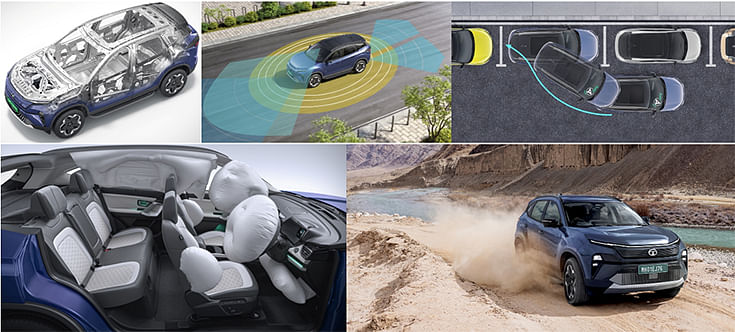Tata Motors powers up Harrier appeal with new electric variant
With both single- and dual-motor options, the Harrier EV is uniquely positioned as a rugged all-wheel drive, all-electric SUV that also boasts of advanced technology with a new digital-interface layer powering modern-day connectivity and features.
Tata Motors, which has recently launched the Tata Harrier EV, the all-electric version of its rugged, full-size, monocoque SUV, aims to widen the appeal of this proven product that was first introduced in India in CY2019.
Since the Tata Harrier’s rollout, Tata Motors has clocked total wholesales of 142,608 units till end-June 2025, and had also lent a midlife makeover to the diesel-only Harrier in CY2023. While a market transition towards petrol SUVs has seen the Harrier’s sales down for two consecutive fiscals, the company has been quicker to adapt to the electrification trend by introducing the Harrier EV.
Launched on June 27 with prices ranging from Rs 21.49 lakh to Rs 28.99 lakh, ex-showroom, the Harrier EV aims to widen the appeal of Tata’s rugged SUV to a wider audience which is now seeking cleaner propulsion options due to growing governmental restrictions dissuading buyers from opting for diesel-powered vehicles.
The Harrier EV is uniquely positioned as a full-size, all-wheel drive electric SUV that comes powered by two electric motors – one on each axle – in its all-wheel drive or ‘Quad Wheel Drive’ version, the latter in Tata’s marketing nomenclature. While Tata Motors has leveraged the existing Harrier to undertake this ICE-to-EV conversion, the company has made significant changes to its underpinnings, including the suspension and chassis, to seamlessly incorporate the battery pack which sits on the floor between the two axles.
According to Tata Motors, the chassis has been modified to eliminate the exhaust tunnel which is particularly evident in the rear floor pan area of an ICE vehicle, and turn it into a completely flat member to accommodate the battery pack. The company has termed this revised platform as its ‘acti.ev plus’ architecture, which also extends to other layers, including a completely new digital-interface layer that enables several software-oriented modern functions on the Harrier EV.
Tata Motors has also uprated the torsional stiffness of the chassis by introducing high-tensile members that determine new load paths to distribute the impact of frontal, lateral, as well as vertical forces across the monocoque, thereby strengthening the cabin integrity. As a result, the Harrier EV has scored a full five-star rating in the Bharat NCAP crash tests and boasts benchmark scores of 32/32 for adult occupant protection and 45/49 for child occupant safety.

The Harrier EV comes equipped with top-notch active and passive safety equipment, including seven airbags, ESC, and radar-cum-vision-based Level-2 ADAS. The ADAS suite offers features such as lane-keep assist, adaptive cruise control, and autonomous emergency braking (AEB), with a setting to disable the latter for slow-speed and congested driving environments.
Despite a raised boot floor that houses the spare wheel, the SUV also boasts a storage capacity of 502 litre, expandable up to 999 litre with the second-row folded flat. Furthermore, there is the presence of a front stowage box under the hood that offers 67-litre storage in the rear-wheel drive version, and a 35-litre capacity in the all-wheel drive variant.
 Styled to win over buyers
Styled to win over buyers
From the outside, the Harrier EV retains the unmistakable Harrier silhouette with its imposing design cues such as a raised bonnet, flared wheel arches, tall stance and a rising belt line which complements the large door panels. Full-LED lighting upfront, an enclosed grille in the EV version, and diamond-cut, aero-optimised 19-inch wheels give it a distinctive yet recognisable appearance. Tata Motors offers the Harrier EV in five colour options – Nainital Nocturne, Pristine White, Pure Grey, Empowered Oxide, and Matte Stealth Black.
On the inside, the cabin gets a dual-tone layout with electronically-adjustable memory and ventilated seats upfront, rear comfort headrests with a flip-down armrest, a panoramic sunroof, and ambient lighting synced with drive modes as well as music. The flat floor at the rear liberates adequate space for a third occupant on the rear bench, whereas dual-zone climate control with integrated rear AC vents on the B-pillar aid towards enhancing occupant comfort.

 Tech tour de force
Tech tour de force
The centrepiece of attraction inside the Harrier EV’s cabin is a 14.53-inch digital infotainment display sourced from Samsung. The QLED screen is complemented by a fully-digital instrument cluster that also doubles up as the navigation display. Both the screens are powered by Harman’s intuitive human-machine interface that also offers a host of entertainment-cum-drive setting features embedded in the touchscreen.
The Harrier EV gets a 10-speaker Harman Black audio setup with Dolby Atmos, wireless phone charging upfront, a dual-65W mobile charging port at the rear, and a segment-first electronic IRVM which also doubles up as a dual front-and-rear dash cam that records footage in full-HD resolution. A 540-degree surround-view camera, digital key with e-access through mobile phone, as well as a summon mode with auto-park assist make the Harrier EV offer the latest in technology through its digital layer that enables seamless interaction with the occupants, as well as infrastructure.
The car comes with Tata’s ‘Arcade.ev’ suite of applications that offer entertainment features like gaming that can be accessed while the vehicle is stationary, such as during charging, as well as an integrated digital wallet – DrivePay – that enables contactless payments at parking booths and charging stations which can be identified using the in-built connectivity. Tata Motors has christened this digital layer in the Harrier EV as TiDAL, which is an acronym for Tata Intelligent Digital Architecture Layer, that empowers the connectivity, ADAS suite, as well over-the-air updates for receiving frequent feature upgrades and improvements throughout the vehicle lifecycle by virtue of several domain-specific controllers.

State-of-the-art electric drivetrain
The Harrier EV comes with two battery pack options – 65kWh and 75kWh – with the company claiming a range of 538km for the former and up to 627km for the latter, which also comes with the option of a dual-motor setup or Quad Wheel Drive (QWD) in Tata-speak.
The Harrier EV is a rear-wheel drive SUV by default, wherein it sees the primary PMMS motor develop 238hp. In the QWD variant, the front induction motor assists the primary motor by developing an additional 158hp to take the combined power output to 313hp and 504Nm of peak torque value. The company has calibrated the drivetrain to deliver the power in a linear fashion, wherein the Harrier EV QWD claims a 0-100kph time of 6.3 seconds with the ‘boost’ mode assist.
With an independent front and rear suspension that now gets frequency-dependent damping (FDD) shock absorbers, the Harrier EV offers a composed ride even over broken patches that are cushioned away from the cabin. While a low centre of gravity aids handling, the tall stance of the SUV induces some vertical movement at higher speeds around corners. Tata Motors has focused on the off-road capability of this all-electric SUV, which offers six terrain modes, including mud-and-rut, sand, and snow, among others, to differentiate the Harrier EV from its chief rivals in the price segment.
Tata Motors claims a charging rate of C1.5, with the Harrier EV capable of recharging from 20% SOC to 80% in 25 minutes with a 120kW DC fast charger. The battery pack, comprising cylindrical cells sourced from Octillion Power Systems, is liquid cooled and comes with a lifetime warranty. With a growing market for technologically-advanced, and value-for-money EVs, the latest all-electric introduction from the homegrown automaker is aimed at expanding its EV market share which stands at 38% in H1 CY2025.
Size-wise, the Harrier EV is a direct competitor to Mahindra’s all-electric XEV 9e and BE 6 SUVs which are built on a ground-up EV platform and adopt a completely different approach of eyeing the electric vehicle market with a futuristic design language. Tata Motors, on the other hand, has deployed a tried-and-tested formula and offered a more realistic-looking and relatable product in the Harrier EV that promises zero tailpipe emissions, but in a highly capable package.
Tata Motors is bullish about the Harrier EV giving it a fresh charge in India's competitive electric SUV market. Let's wait and see how the value-conscious EV buyer takes to the latest zero-emission vehicle from the company.
RELATED ARTICLES
Digital Design Transforms India's Auto Sector
Auto makers leverage Modelling and Simulation (ModSim) to cut development cycles from five years to under two, reshaping...
Zen Mobility’s Micro Pod Aims to Bridge Last-Mile Delivery Gap
With modest sales, expansion plans, and bets on future tech, Zen Mobility has to focus on execution to ensure that its '...
The Design Strategy Behind Mahindra's Remarkable Rise
How Mahindra went from relying on global design houses to building a future-ready, digitally empowered, and globally cap...





 26 Jul 2025
26 Jul 2025
 844 Views
844 Views


































 Shahkar Abidi
Shahkar Abidi


 Yukta Mudgal
Yukta Mudgal

 Darshan Nakhwa
Darshan Nakhwa

